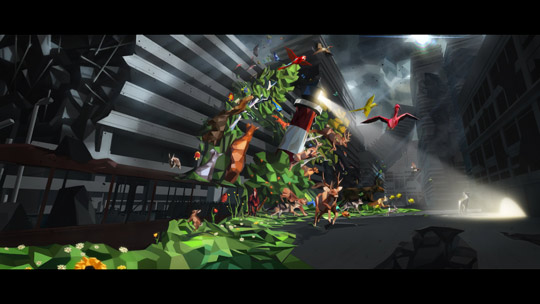
A Transmedia Story
Posted on Jul 12, 2011 by Alex Fice
Academy Awarded director Guillermo Del Toro and cinematographer Guillermo Navarro will run the new Mirada company aside Mathew Cullen and Javier Jimenez. They are producing media for everything.
More than ever companies are integrating ad campaigns across different media platforms to enhance a brand and define its soul. Simon Wakelin reports
Transmedia. You’ve heard the term and jive with its concept: a method of conveying messages, themes or storylines to a mass audience through the well placed and artful use of different media platforms. Play well across media and you’ll enhance a brand’s story and solidify its dominance and pervasiveness in the marketplace. In short you make it relevant.
Transmedia is used today as a way to advertise product in a splintered digital world, but it actually goes back to a concept used by Nintendo to market a new product on its hands.
It was the mid ‘90s, and the company was already content with a strong foothold in the video game market with Donkey Kong and the Mario / Super Mario series.
Nintendo’s next move was to bring out Pokemon. Initially a “monster collecting role-playing game” for its Nintendo DS system, Pokemon quickly became a media franchise of epic proportions with merchandise that stretched across different platforms such as anime comic books, video games, TV shows and Pokemon’s ever-popular trading cards. All these experiences motivated ever more consumption from bona fide fans.
 © Simon Wakelin
© Simon Wakelin
Consumers became active hunters and gatherers on an epic scale. Pokemon went on to become the Rubik’s Cube of the ‘90s, today the second most successful and lucrative video game in world history, second only to Nintendo’s beloved Mario.
Fast-forward 15 years and similar innovation is thriving as progressive companies create exciting work in new digital spaces. Venice-based B-Reel is no exception. A recipient of five Cyber Lions at 2010’s Cannes International Advertising Festival, B-Reel specializes in high-end web productions, film and animation work. Working synergistically with sister company B-Reel Films (a traditional production company with its own roster of directors), B-Reel operates as a one-stop-shop.
Omincom Group’s 180/LA recently teamed up with B-Reel Films director Anders Hallberg on Mitsubishi’s Live Drive. Teasers were created to entice viewers to take a test drive of the company’s new Outlander Sport – online.
“It’s the world’s first online test drive,” says B-Reel exec producer Pelle Nilson.
“We specialise in uncovering new digital outlets and solutions, new ways to reach and influence target audiences through integrated campaigns.” With the growing adoption of HTML5 and advanced JavaScript there are sure to be similar types of advertising on offering.
B-Reel’s collaboration with Google Creative Lab also illustrates how an audience can be hooked experiences that engage their emotions. Promoting Google Chrome technology, The Wilderness Downtown set to Arcade Fire’s We Used To Wait, that marks a successful collaboration between directors Chris Milk and Aaron Koblin through @radical.media.
Upon arriving you are asked to type in your home address, then, thanks to Google Maps and Google Street View, the film takes you on a personal journey – via multiple windows – through your own hometown while footage directed by Milk plays alongside. It’s an absorbing experience.

 Image from Mirada’s Rome project. Another image from Mirada’s Rome project.
Image from Mirada’s Rome project. Another image from Mirada’s Rome project.
LA-based MOTHERSHIP also delivers media solutions for its film, advertising and gaming industry clients. Launched just under a year ago it operates through Digital Domain, one of the world’s foremost digital production companies.
“We create entertainment marketing,” explains MOTHERSHIP president Ed Ulbrich. “We create marketing and messaging true to the methodology and spirit of each project. That product is then blown out across multiple platforms because single screen content is a dinosaur. We’re now shaping the work for multiple screens.”
MOTHERSHIP is also evolving the careers of commercial directors in an attempt to garner longer format work. “A script isn’t enough to get a movie off the ground anymore, so we help commercial directors make their first film,” explains Ulbrich, noting a full art department on site dedicated to nurturing talent. “Directors use our digital tools to build a visual sample, a prototype of what their movie will look like and then we build a creative pitch for them. We’re very focused on expanding and building our roster of directors.”
Academy Awarded director Guillermo Del Toro also brings unique storytelling opportunities to the media-frenzied advertising world of the west coast with the opening of Mirada [www.mirada.tv]. He and cinematographer Guillermo Navarro will run the shop aside Mathew Cullen and Javier Jimenez, both co-founders of LA-based commercial design and production company Motion Theory.
The principals collective experience stretch across many mediums; for example, Motion Theory’s wisdom in the advertising and music business and Del Toro’s expertise writing novels, creating video games, producing, writing, directing movies and developing television. Cullen describes Mirada as a playground for artists, a workshop to create meaningful stories, “a place where storytelling and pop culture will collide.”
Cullen believes that to emotionally engage the audience, “requires elaborately constructed stories that have at their core sharply felt human emotions.”
“The question really becomes what is more important, content or distribution?” posits Cullen. “It’s content because once you plug in and provide a genuine experience for the audience they then share the work with others. People today are using media in ways that have completely changed our business model.”
Consumers will continue to invest deeply in brands, while brands themselves will continue trying to engender trust and loyalty in its customers through multiple delivery platforms. New hybrid agency / production companies will also need to constantly evolve and continue to develop appropriate strategy for an environment constantly in flux.
“The most successful strategy is having collaborative leadership,” offers Cullen on the subject. “It’s understanding how to create and manage creation using whatever the specific medium, or mediums, may be. Some stories are just designed to be told in one capacity; a great book is never designed to be turned into a movie – but there are projects that are made to expand across everything from video games to merchandizing opportunities.”
However much a brand’s reputation is at stake, one thing is for sure: at the heart of it, if the audience is entertained they will watch and share.
“If the story has heart, and the brand has an integrated cross platform approach and blown out to the appropriate platforms then the sky is the limit,” says Ulbrich.
“the key is to get the message out there using great ideas, creativity and true innovation.”


















